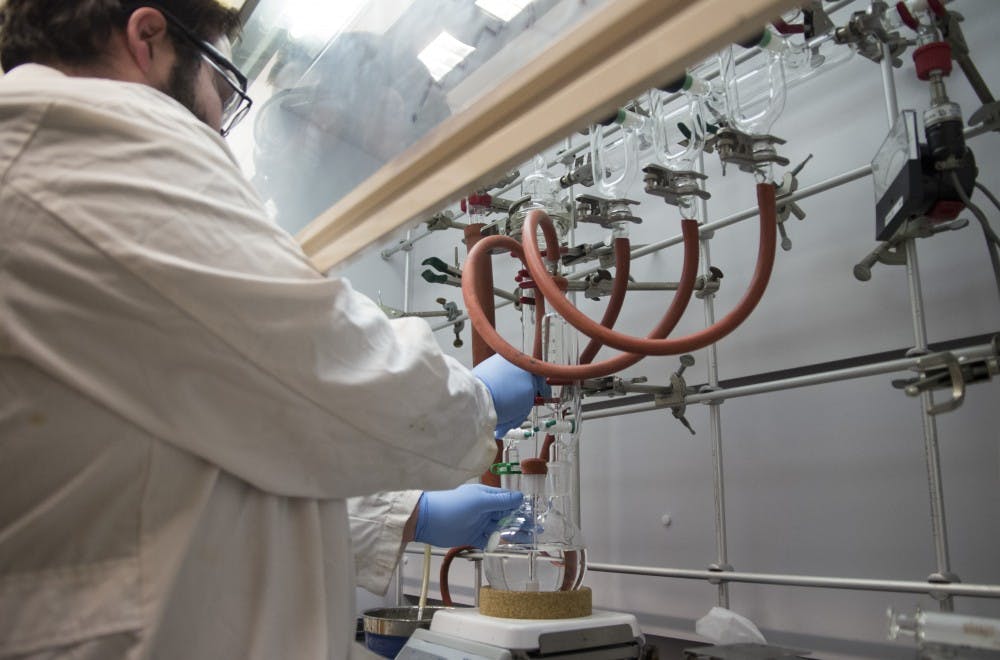Elizabeth Dirk, assistant professor in the department of chemical and nuclear engineering, is leading an interdisciplinary team in the Center for Biomedical Engineering, working to tackle several aspects of this complex science. In particular, her lab focuses on the regeneration of heart valves and bone tissue to replace current transplant options, such as biological, from a donor animal or human, or synthetic.
“As tissue engineers, if we can figure out a way to make your valve grow back as healthy tissue or implant healthy tissue and have it integrate into your body, (engineered tissues) would be the ideal course. Your body would be able to take over that tissue, regenerate, and keep it healthy for you,” said Kent Coombs, a biomedical science graduate student in Dirk’s lab.
To custom-make a new organ, the lab is experimenting with different approaches. The first is to implant a special scaffold that will cause the body’s own cells to grow onto it and regenerate the organ while actually inside the host. The scaffold would then dissolve, leaving only the new organ behind.
The second is to grow the organ on a scaffold in the lab and then implant the fully-functioning organ. Ideally, all cells would come from the person into which the organ will go, so it would literally be their own organ.
Yet the task is a large order and requires numerous considerations from how to treat the individual cells needed to recreate the organ to deciding the best material for the scaffold and how to make it.
For each organ being targeted for regeneration, a different scaffold must be designed that mimics the natural properties of that organ. For example, to recreate bone the scaffold must be very hard, whereas to regenerate a heart valve it needs to be softer and more pliant.
In both cases, the scaffold must dissolve, but only at a specific point once the organ is fully formed. Dirk’s lab has successfully manipulated different scaffold materials to control their degradation time to anywhere from a few weeks to a few years, depending on the need. The lab has also developed and recently patented several novel techniques for making scaffold systems that will likely be the basis for new biotech company start-ups here in the Albuquerque area.
Once the correct scaffold has been created, the cells must be coerced into re-creating the organ rather than simply growing into a blob of tissue or forming something like a scar.
“One of the challenges in tissue engineering is making sure that you understand the system that you are trying to regenerate,” said Matthew Rush, a nanoscience and microsystems engineering graduate student who also works in Dirk’s lab.
This means that even if scientists develop a way to regenerate one type of tissue, they may still be starting from scratch with another type.
“Most organs are made out of many, many cell types. So not only do you have to understand one cell type, you have to understand them all and how they interact,” Coombs said.
Get content from The Daily Lobo delivered to your inbox
To combat these challenges, Dirk has compiled a group of scientists with diverse backgrounds — her lab includes people with expertise in everything from engineering to chemistry to biology. A uniquely collaborative effort, there are only a handful of labs in the world doing what her group is.
While the heart valve project is in its earlier stages, Dirk said her lab’s system for bone regeneration is much farther along and poised to start more advanced stages of testing. However, the lengthy FDA approval process means that it will likely be at least 10 years before their system reaches an actual patient.
Still, lab-regenerated tissue has uses even at this stage, with potential applications in the study of disease progression. Dirk’s lab, while trying to convince cells to grow into a healthy heart valve, accidentally caused them to grow in a way that seemed to perfectly mimic a valve seen in a form of heart disease.
“It’s not very well understood how heart valve disease starts and progresses,” Dirk said. “There’s actually not a very good tissue model for it.”
Instead, her lab’s accidental, unwanted discovery could be an easy and accurate model that other scientists can use to study the disease. Dirk’s lab, however, is keeping their focus on growing healthy tissue and getting the technology to the point where it can help the people who need it.
“We want to learn how to keep these cells in a healthy state, produce and maintain appropriate tissue and prevent disease progression,” Dirk said.
Lauren Topper is a freelance reporter at the Daily Lobo. She can be contacted at news@dailylobo.com or on Twitter @DailyLobo.






